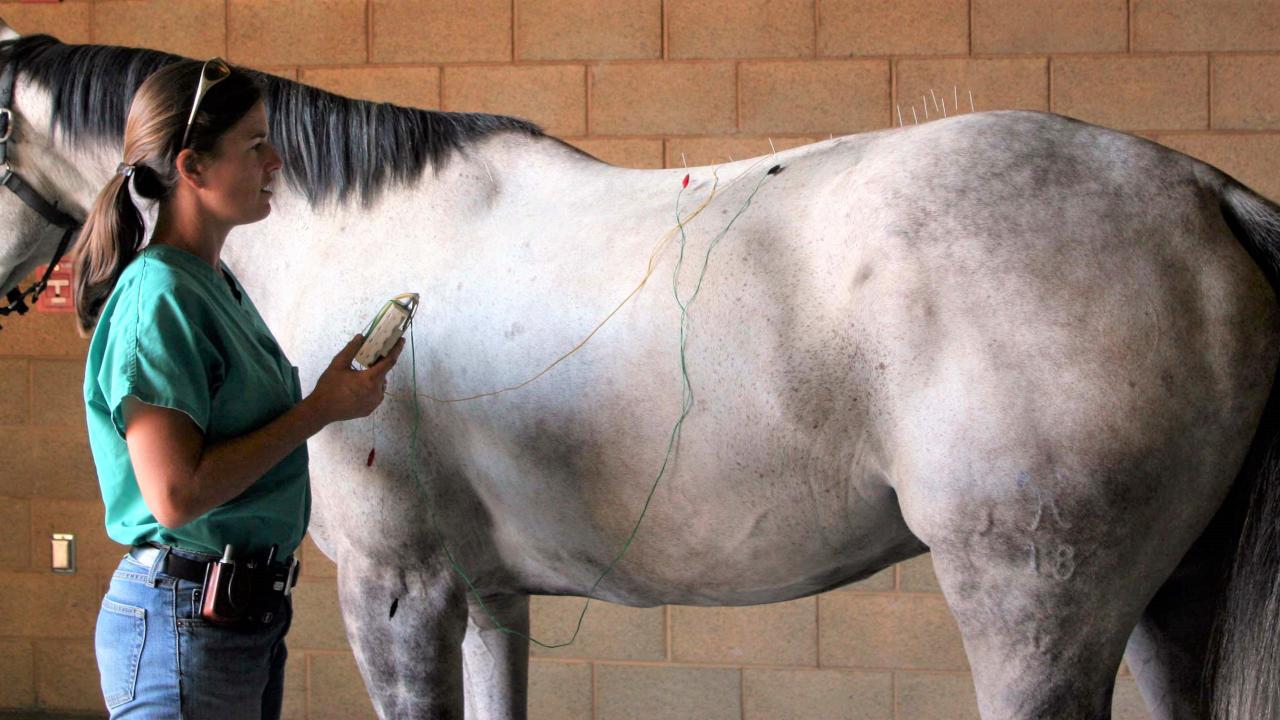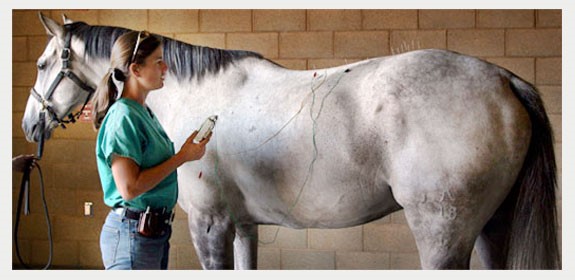
Acupuncture In Horses
What are acupuncture and Traditional Chinese Veterinary Medicine (TCVM)?
Takeaways
- Acupuncture typically involves the insertion of fine needles through the skin at particular points to cause therapeutic effects.
- It can be used in conjunction with conventional veterinary medicine to treat various equine medical conditions and to relieve pain.
- Acupuncture is a safe medical procedure with minimal unwanted side effects when performed by a qualified veterinarian.
Acupuncture has been used to treat various medical conditions in humans and animals for more than 3,000 years. Horses were among the first animals treated with acupuncture due to their importance in warfare and farming. Today, equine acupuncture is commonly incorporated in the treatment of a number of conditions, especially musculoskeletal disorders and back pain.
The ancient Chinese discovered and described hundreds of acupuncture points (acupoints) in humans and animals. Modern research shows that acupoints are located in areas with a high density of free nerve endings, mast cells, small arterioles and lymphatic vessels. Stimulation at acupoints induces the release of beta-endorphins, serotonin and other neurotransmitters and can produce local, remote, and/or systemic effects. The use of acupuncture for pain relief is well supported by modern research studies. The effects of acupuncture on internal organs and on “balancing” the body as a whole are less understood, and more research is necessary to fully explain this ancient therapy.
The benefits of acupuncture have been widely recognized and integrated into Western veterinary and human medical practices. In November 1997, the National Institutes of Health (NIH) convened a panel of scientists to review the effectiveness of acupuncture. The result was the first formal endorsement of acupuncture by the NIH, stating: “There is sufficient evidence of acupuncture’s value to expand its use into conventional medicine and to encourage further studies of its physiology and clinical value.”
Acupuncture is a sought after treatment by horse owners due to its demonstrated safety and minimal unwanted side effects. It is well tolerated by most horses and provides a drug-free approach to address musculoskeletal pain that can enhance equine performance. This is particularly attractive for competitors who must adhere to show association-mandated prohibited substance policies. Aside from the needles, acupuncture does not require any specialized equipment, making it easier to perform in a variety of environments than some traditional methods.
When is acupuncture indicated?
Clinical trials indicate that acupuncture therapy can be effective as a supplemental treatment in the following conditions in horses:
- musculoskeletal problems: muscle soreness, back pain, neck pain, osteoarthritis, degenerative joint disease, obscure lameness, laminitis
- gastrointestinal disorders: diarrhea, impaction, chronic colic, gastric ulceration
- neurological disorders: seizure, laryngeal hemiplegia, facial and radial nerve paresis
- other chronic conditions: heaves (COPD, RAO, asthma), anhidrosis, uveitis, behavioral problems, Cushing's disease, hypo- or hyperthyroidism, infertility, renal failure, geriatric weakness, skin problems, performance enhancement and prevention of disease
What physiological effects are induced by acupuncture?
- pain relief
- promotion of microcirculation
- regulation of gastrointestinal motility
- anti-inflammatory effects
- hormone and reproductive regulation
- immuno-regulation
- anti-febrile (fever reducing) effect
Are there situations in which acupuncture should not be used?
- fracture
- infectious conditions
- open wounds
- pregnancy
What are acupuncture methods?
Diagnosis: An acupuncturist’s diagnosis is based, in part, on conventional Western methods: obtaining a thorough medical history, discussing the primary complaint and goals for improvement, performing a physical exam, blood work, radiographs, ultrasound, etc. A diagnostic acupoint palpation exam will be performed that will identify particular painful acupuncture points, indicating local and referred pain.
Treatment: Modern acupuncture needles are 0.5 – 3 inches long, ultra-fine, and made of a flexible stainless steel. They are pre-sterilized, non-toxic and disposable. Depending on the condition being treated, 5 – 30 needles will be inserted and left in place for 5 – 30 minutes. Stimulation of acupoints by needles can be done by rotating the needles or attaching electrodes to send a weak electrical current through the needles (electroacupuncture). Heating the needles with a burning moxa herb (moxibustion) may be indicated in certain conditions.


How long does each acupuncture session last?
Each session may take between 20 – 60 minutes.
How many treatments are needed?
The number of treatments depends on the nature, severity and duration of the disease. A single treatment may be enough for a very acute condition but generally 3 – 5 treatments are necessary to obtain results for chronic conditions. Some animals may need to be treated at regular intervals to prevent recurrence of degenerative conditions.
How safe is acupuncture?
Acupuncture is a safe medical procedure when performed by a qualified veterinarian. Very few negative side effects have been reported in clinical cases. However, acupuncture is not a replacement for conventional veterinary medicine.
Does acupuncture hurt?
More than 95 percent of human patients tolerate acupuncture very well and experience profound relaxation. Typically, acupuncture will produce a tingling or “heavy” sensation at the acupoint. Most animals tolerate this well and progressively relax throughout the duration of the treatment.
For more information:
UC Davis, School of Veterinary Medicine, Equine Integrative Sports Medicine Service: https://www.vetmed.ucdavis.edu/hospital/large-animal/equine-sports-med
*This article may not be reproduced without the written consent of the UC Davis Center for Equine Health. Please email requests to cehadmin@ucdavis.edu.
